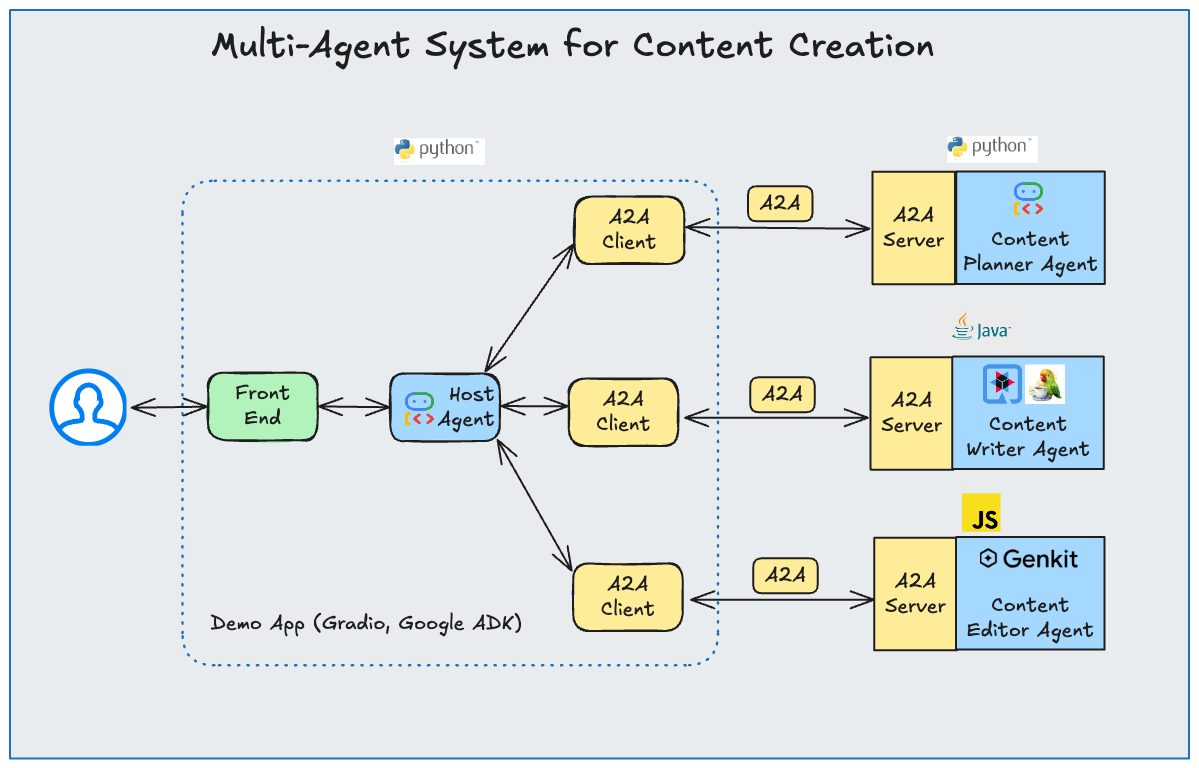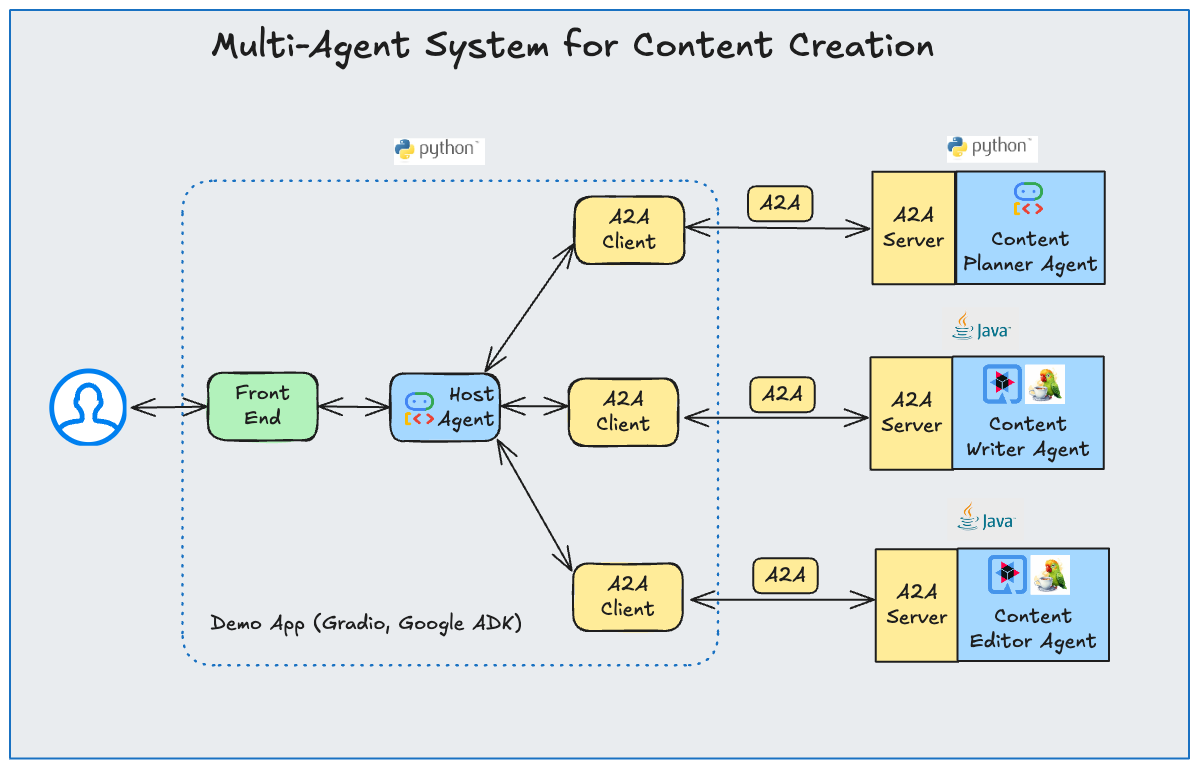Multi-Language Agent Collaboration and Interoperability with A2A
Building a multi-agent system can involve using different languages to meet specific needs. The Agent2Agent (A2A) protocol is an open standard that enables AI agents to communicate and collaborate with one another, regardless of each agent’s underlying technology stack.
In this post, we’ll see how to create a multi-agent system, where agents written in Java, Python, and TypeScript work together to accomplish a goal: content creation. The multi-agent system uses A2A for communication between the AI agents.

Content Creation Sample
We’re going to do a deep dive into the Content Creation sample from the a2a-samples project.
This sample showcases a content creation pipeline with a Host agent that acts as the central orchestrator,
dynamically routing requests to a set of specialized agents.
Agents
Here’s a quick overview of all the agents in our multi-agent system:
| Agent | Role | Technology Stack | Description |
|---|---|---|---|
Host |
A2A Client |
Python, Google ADK, A2A Python SDK |
Serves as the central orchestrator, routing requests to the appropriate agent based on the task at hand. |
Content Planner |
A2A Server |
Python, Google ADK, A2A Python SDK |
Receives a high-level content request and creates a detailed content outline. |
Content Writer |
A2A Server |
Java, Quarkus LangChain4j, A2A Java SDK |
Generates engaging content from a content outline. |
Content Editor |
A2A Server |
TypeScript, Genkit, A2A JS SDK |
Proofreads and polishes the given content. |
Notice that the agents are written in different programming languages and make use of different LLM frameworks. This is to demonstrate what’s possible with the A2A protocol.
Handling a Content Creation Request
Upon receiving a content creation request from the user, the Host agent breaks down the content creation task
into a few different sub-tasks: planning, writing, and editing.
Dynamic Agent Selection
The Host agent uses an LLM and the agent cards from our specialized A2A server agents to determine which agent to assign a particular sub-task to. For example, let’s take a look at the agent card for our Content Writer agent:
{
"name": "Content Writer Agent",
"description": "An agent that can write a comprehensive and engaging piece of content based on the provided outline and high-level description of the content",
"url": "http://localhost:10002",
"version": "1.0.0",
"documentationUrl": "http://example.com/docs",
"capabilities": {
"streaming": true,
"pushNotifications": false,
"stateTransitionHistory": false
},
"defaultInputModes": [
"text"
],
"defaultOutputModes": [
"text"
],
"skills": [
{
"id": "writer",
"name": "Writes content using an outline",
"description": "Writes content using a given outline and high-level description of the content",
"tags": [
"writer"
],
"examples": [
"Write a short, upbeat, and encouraging twitter post about learning Java. Base your writing on the given outline."
]
}
],
"supportsAuthenticatedExtendedCard": false,
"additionalInterfaces": [
{
"transport": "JSONRPC",
"url": "http://localhost:10002"
}
],
"preferredTransport": "JSONRPC",
"protocolVersion": "0.3.0"
}|
The agent card for an A2A server agent can be found using its Well-Known URI, e.g., for the |
The description and skills specified in the agent card for the Content Writer agent allow the Host agent’s LLM to determine that the writing sub-task should be sent to the Content Writer agent.
Agent Communication
The Host agent communicates with each A2A server agent using an A2A client. Notice that an A2A client
does not need to be written in the same programming language as an A2A server since all that matters is
that both are using the A2A protocol to communicate with each other.
Later on in this post, we’ll see how we can easily swap out the TypeScript Content Editor agent for
an equivalent agent written in Java, highlighting the flexibility and interoperability that’s made
possible by the A2A protocol.
Running the Agents
Let’s get this multi-agent system running locally.
Content Planner
In a terminal:
cd samples/python/agents/content_plannerFollow the instructions in the content_planner README.md to start the Content Planner agent.
Content Writer
In a terminal:
cd samples/java/agents/content_writerFollow the instructions in the content_writer README.md to start the Content Writer agent.
Content Editor
In a terminal:
cd samples/js/src/agents/content-editorFollow the instructions in the content-editor README.md to start the Content Editor agent.
Host
In a terminal:
cd samples/python/hosts/content_creation
uv run .|
As mentioned in the agent |
Access the Content Creation Application
Now that all of our agents are up and running, from your browser, navigate to http://localhost:8083.
Try asking questions like:
-
Create a short, concise LinkedIn post about getting started with the Agent2Agent protocol
-
Create a short, upbeat X post about Quarkus LangChain4j

Swap Out an Agent
One of the most powerful features of the A2A protocol is its interoperability. Let’s see this in
action by swapping out the TypeScript-based Content Editor agent for an equivalent agent written
in Java.

Stop the TypeScript Content Editor Agent and Host Agent
First, stop the Host agent and the Content Editor agent so we can swap out the Content Editor agent for
an equivalent agent written with Java instead of TypeScript.
Start the Java Content Editor Agent
In a terminal:
cd samples/java/agents/content_editorFollow the instructions in the content_editor README.md to start the Content Editor agent.
Access the Content Creation Application
From your browser, navigate to http://localhost:8083 and try asking some questions.
This time, the Host agent will seamlessly use the Java-based Content Editor agent for editing
content instead of the TypeScript-based Content Editor agent. This flexibility is made possible
because the A2A protocol is language-agnostic. This can be really useful for prototyping agents
in one language to get things up and running quickly and then migrating to another language for
a production environment.
Conclusion
In this post, we saw how to use the A2A protocol to enable agents written in different programming languages and with different LLM frameworks to collaborate seamlessly to accomplish a goal. We also saw how easy it is to swap out one of the agents for an equivalent agent written in a different language.
